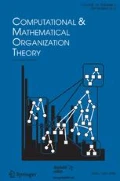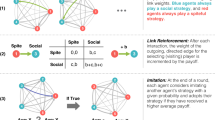Abstract
We study here dynamic antagonism in a fixed network, represented as a graph G of n vertices. In particular, we consider the case of k≤n particles walking randomly independently around the network. Each particle belongs to exactly one of two antagonistic species, none of which can give birth to children. When two particles meet, they are engaged in a (sometimes mortal) local fight. The outcome of the fight depends on the species to which the particles belong. Our problem is to predict (i.e. to compute) the eventual chances of species survival. We prove here that this can indeed be done in expected polynomial time on the size of the network, provided that the network is undirected.
Similar content being viewed by others
References
Bshouty N, Higham L, Warpechowska-Gruca J (1999) Meeting times of random walks on graphs. Inf Process Lett 69:259–256
Imhof LA (2005) The long-run behaviour of the stochastic replicator dynamics. Ann Appl Probab 15(1B):1019–1045
Kandori M, Mailath GJ, Rob R (1993) Learning, mutation and long run equilibria in games. Econometrica 61(1):29–56
Maynard Smith J (1982) Evolution and the theory of games. Cambridge University Press, UK
Norris J (1997) Markov chains. Cambridge University Press, UK
Ross S (2001) Probability models for computer science. Academic Press, San Diego
Samuelson L (1997) Evolutionary games and equilibrium selection. MIT, Cambridge
Tetali P, Winkler P (1991) On a random walk problem arising in self-stabilizing token management. In: Proceedings of the 10th Annual ACM Symposium on Principles of Distributed Computing. ACM Press, Montreal, pp 273–280
Weibull JW (1995) Evolutionary game theory. MIT, Cambridge
Author information
Authors and Affiliations
Corresponding author
Additional information
This work was partially supported by the IST Programme of the European Union under contact number IST-2005-15964 ( \(\mathsf{AEOLUS}\) ) and by the Programme \(\mathsf{PENED}\) under contact number 03ED568, co-funded 75% by European Union—European Social Fund (ESF), 25% by Greek Government—Ministry of Development, General Secretariat of Research and Technology (GSRT), and by Private Sector, under Measure 8.3 of O.P. Competitiveness—3rd Community Support Framework (CSF).
Rights and permissions
About this article
Cite this article
Nikoletseas, S., Raptopoulos, C. & Spirakis, P. The survival of the weakest in networks. Comput Math Organ Theory 15, 127–146 (2009). https://doi.org/10.1007/s10588-008-9050-2
Published:
Issue Date:
DOI: https://doi.org/10.1007/s10588-008-9050-2




